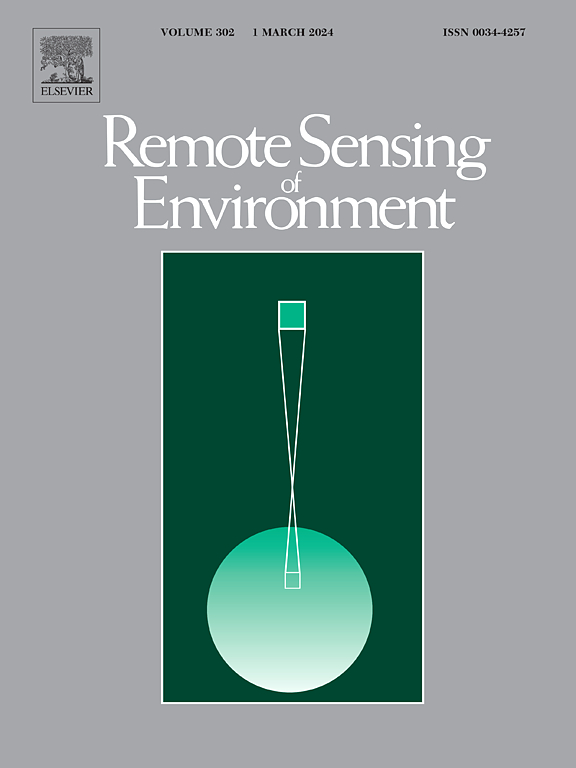Spatially continuous mapping of pre-fire fuel characteristics with imaging spectroscopy and lidar for fire emissions modeling
IF 11.1
1区 地球科学
Q1 ENVIRONMENTAL SCIENCES
引用次数: 0
Abstract
Fuels are a large source of uncertainty in fire emissions estimates due to variability in the physical and chemical properties of fuels and how they are represented. These uncertainties can be addressed using imaging spectroscopy and lidar data, that provide observations of the chemical and physical traits and spatial distribution of vegetation. Combined with ground fuel measurements, these data provide information on fuel distribution and quantity important for mapping and modeling fire effects. In this study, we present a methodology to develop models and continuous maps of pre-fire fuel characteristics for use in fire emissions modeling. We first addressed any spatial gaps over fire areas for Airborne Visible/Infrared Imaging Spectrometer (AVIRIS) chemical trait data using Random Forests regression and for derived fractional cover. We used the AVIRIS fractional cover and chemical traits or AVIRIS estimates alongside lidar, multispectral, and topographic variables to build fuel characteristic models informed by ground measurements with partial least squares regression. We derived maps of predictive uncertainty alongside a suite of uncertainty statistics for each fuel characteristic that inform the use of fuels data within fire effects models. We used two study sites: the Williams Flats wildfire in eastern Washington state, USA and three prescribed crown fires in Utah, USA. The results show similar error between calibration and validation sets and NRMSE of around 20 % or lower for a majority of the fuel models. We present fuel characteristic and uncertainty maps for all fires. This study shows that the use of imaging spectroscopy and lidar data have the potential to represent fuel heterogeneity and continuously map fuel characteristics for fire effects modeling.
火灾前燃料特性的空间连续映射与成像光谱和激光雷达的火灾排放建模
由于燃料的物理和化学性质及其表示方式的变化,燃料是火灾排放估算中一个很大的不确定性来源。这些不确定性可以通过成像光谱和激光雷达数据来解决,这些数据提供了植被的化学和物理特征以及空间分布的观测结果。与地面燃料测量相结合,这些数据提供了关于燃料分布和数量的信息,这对绘制和模拟火灾效应很重要。在这项研究中,我们提出了一种方法来开发模型和火灾前燃料特性的连续图,用于火灾排放建模。我们首先使用随机森林回归和衍生的分数覆盖来处理机载可见/红外成像光谱仪(AVIRIS)化学性状数据在火灾区域上的任何空间缺口。我们利用AVIRIS的分数覆盖度和化学特征或AVIRIS估计数据,以及激光雷达、多光谱和地形变量,通过偏最小二乘回归,建立了基于地面测量的燃料特性模型。我们导出了预测不确定性图,并为每种燃料特性提供了一套不确定性统计数据,为火灾效应模型中燃料数据的使用提供了信息。我们使用了两个研究地点:美国华盛顿州东部的威廉姆斯平原野火和美国犹他州的三个规定的皇冠火灾。结果表明,在大多数燃料模型中,校准集和验证集与NRMSE之间的误差相似,在20%左右或更低。我们提出了所有火灾的燃料特性和不确定性图。这项研究表明,使用成像光谱和激光雷达数据有可能表示燃料的非均质性,并连续绘制燃料特性,以进行火灾效应建模。
本文章由计算机程序翻译,如有差异,请以英文原文为准。
求助全文
约1分钟内获得全文
求助全文
来源期刊

Remote Sensing of Environment
环境科学-成像科学与照相技术
CiteScore
25.10
自引率
8.90%
发文量
455
审稿时长
53 days
期刊介绍:
Remote Sensing of Environment (RSE) serves the Earth observation community by disseminating results on the theory, science, applications, and technology that contribute to advancing the field of remote sensing. With a thoroughly interdisciplinary approach, RSE encompasses terrestrial, oceanic, and atmospheric sensing.
The journal emphasizes biophysical and quantitative approaches to remote sensing at local to global scales, covering a diverse range of applications and techniques.
RSE serves as a vital platform for the exchange of knowledge and advancements in the dynamic field of remote sensing.
 求助内容:
求助内容: 应助结果提醒方式:
应助结果提醒方式:


